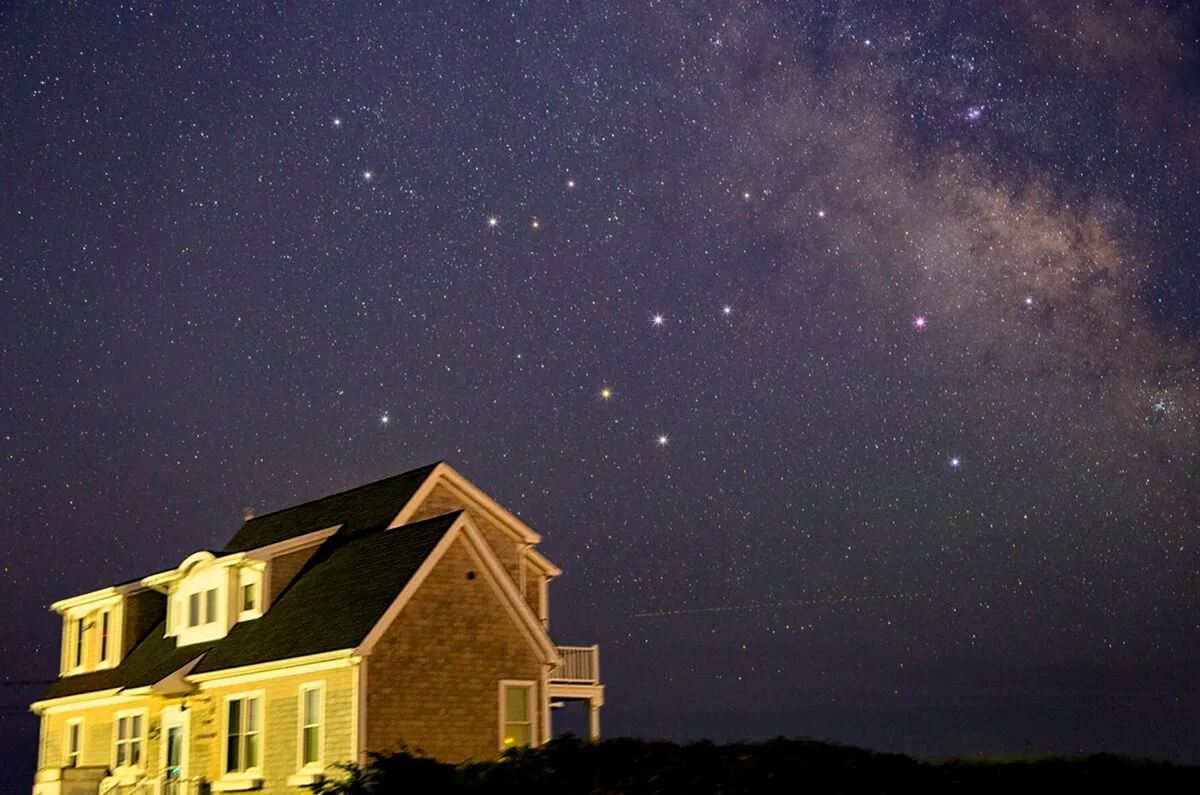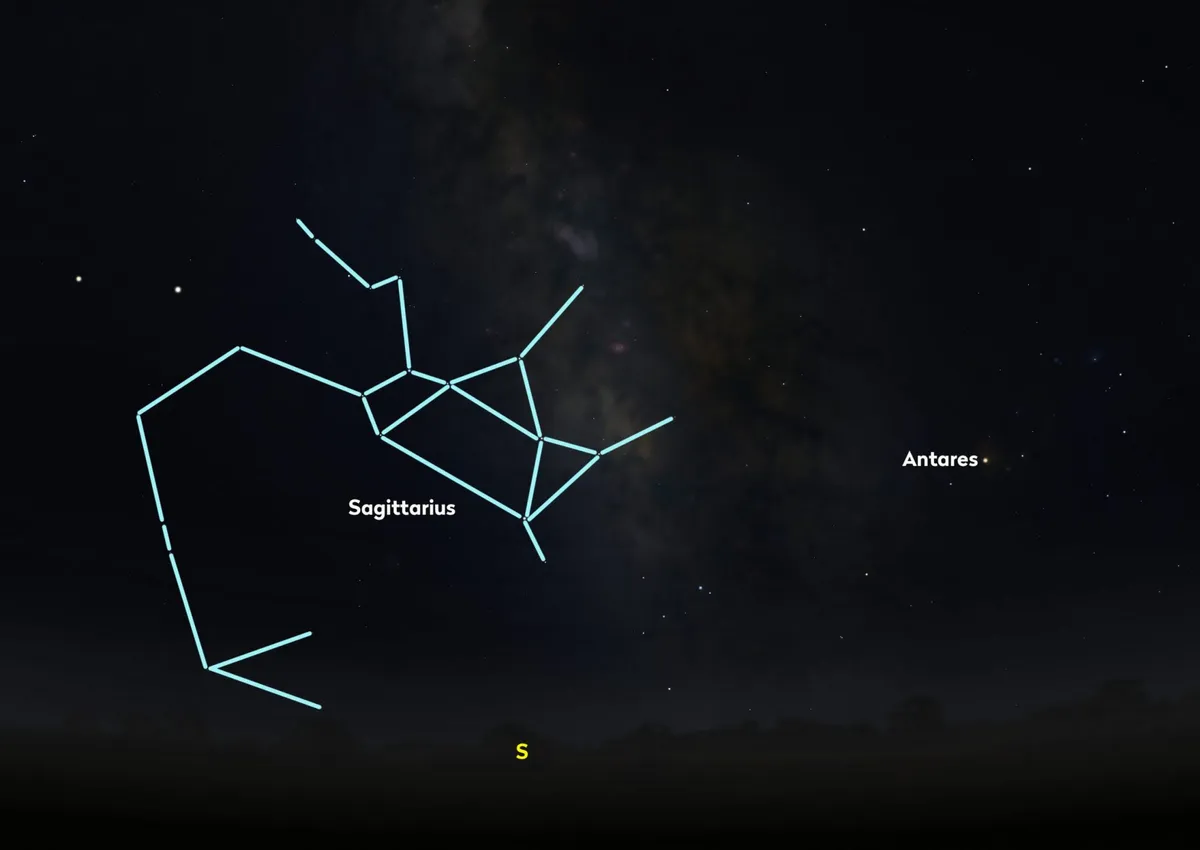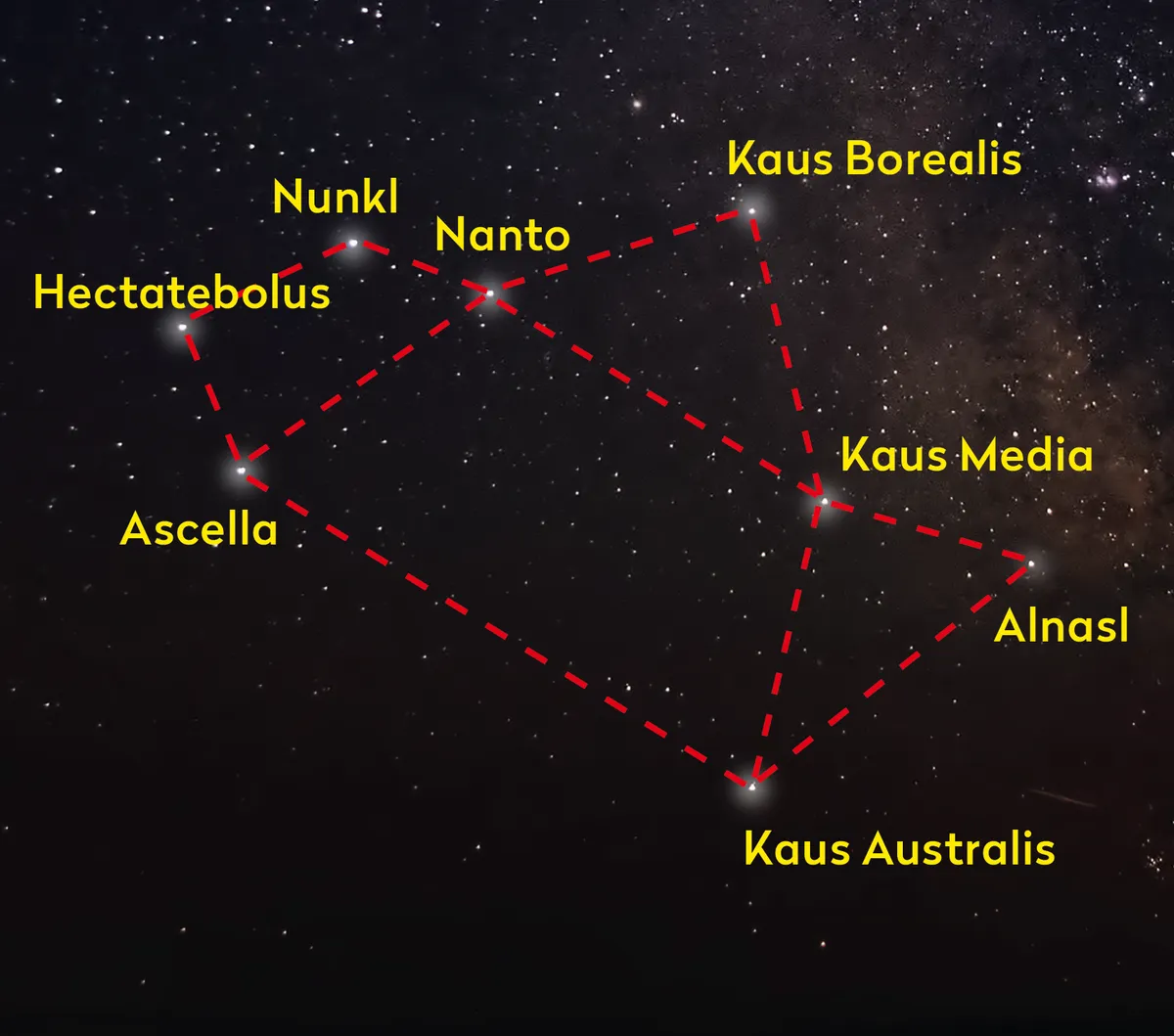The Teapot asterism is a familiar pattern of stars located in the constellation Sagittarius, forming the shape of a teapot and making for one of the most recognisable summer star patterns.
Unlike Sagittarius, which is one of the 88 formally-recognised constellations, the Teapot is a collection of stars visible from Earth known as an asterism.
From the UK, the Teapot asterism never climbs to a significant altitude when it’s at its highest point due south, so make sure you have a clear horizon in order to see it.

The Teapot asterism is visible low along the horizon during the summer months, but as we approach August and the nights get longer, you might even be able to see 'steam' rising from the spout.
This 'steam' is actually the band of the Milky Way arching across the night sky, and if you manage to located both the Teapot and the steam rising from the spout, it's an incredibly satisfying combo!

See star Kaus Meridionalis
The Teapot asterism is formed from a group of stars within Sagittarius, and the star Delta (δ) Sagittarii marks the point where the lid, body and spout are joined.
It had the traditional name Kaus Meridionalis, which refers more to the mythological interpretation of Sagittarius as a centaur archer than a teapot!

There are three stars in Sagittarius named Kaus:
- Kaus Borealis (Lambda (λ) Sagittarii)
- Kaus Meridionalis
- Kaus Australis (Epsilon (ε) Sagittarii)
The name Kaus means ‘bow’, the ‘borealis’, ‘meridionalis’ and ‘australis’ means northern, middle and southern.
In mythology the three stars represent the top, middle and bottom of Sagittarius’s bow.

The Bayer order in Sagittarius isn’t logical, with Kaus Australis brightest at mag. 1.8, then Nunki (Sigma (σ) Sagittarii) at mag. 2.0 and Ascella (Zeta (ζ) Sagittarii) at mag. 2.6. Kaus Meridonalis shines at mag. 2.7 and for once is well labelled as the delta star, because it’s the fourth brightest in Sagittarius.
In case you’re wondering, Rukbat (Alpha (α) Sagittarii) is mag. 3.9, but it’s too far south to be seen from the UK.
Kaus Meridionalis is an orange-giant star with a spectral type of K3 III and an estimated distance from the Sun of 348 lightyears.
It’s a binary system, the companion being a white dwarf. The primary is estimated to be 3.2 times more massive than the Sun with a diameter that’s 16 times larger. It is estimated to be 260 million years old.
Deep-sky objects to observe in the Teapot asterism
The Teapot is undoubtedly a great naked-eye asterism to see in the summer night sky (and is one of our favourite summer constellations and asterisms) but there are some incredible deep-sky objects in its vicinity that are worth observing through a telescope.
Here are 6 of the best deep-sky targets to see in the Teapot. For help locating the objects, download a PDF chartthat you can use at your telescope.
6 targets in the Teapot asterism
1
M22

M22 is a magnificent globular cluster located 2.5˚ northeast of Kaus Borealis (Lambda (λ) Sagittarii), the star at the top of the Teapot asterism’s lid. At mag. 5.1 it is visible to the naked eye, but a telescope brings out its beauty.
From the UK, M22 is compromised due to its low altitude. A 150mm scope at around 200x magnification reveals many resolved stars across the globular’s core.
The whole object is around 20 arcminutes across and appears slightly elongated in a southwest–northeast orientation. Larger instruments resolve further stars.
2
NGC 6642

Globular cluster NGC 6642 sits 1.1˚ west-northwest of M22’s centre. Locating NGC 6642 isn’t the problem, it’s getting detail that proves tricky. Shining at an integrated magnitude of 7.6, NGC 6642 is tiny. A small scope shows it as a 1 arcminute glow. The glow appears larger and brighter through a 250mm instrument, but without obvious resolution.
The best you can expect using averted vision under dark-sky conditions is subtle mottling. Don’t be fooled by several field stars giving the false impression you’re beginning to resolve NGC 6642. A 300mm scope increases the glow’s size to around 1.5 arcminutes, perhaps hinting at a bit of resolution.
3
Collinder 394
This part of the sky is rich with ‘local’ deep-sky objects found within our own Milky Way. In the direction of Sagittarius, you’re looking towards the Galaxy’s core and the number of faint background stars is high. Locate Collinder 394 by using two stars in the Teaspoon asterism.
Extend the line from Omicron (ο) Sagittarii to Xi-2 (ξ2) Sagittarii by three-quarters of their separation again to arrive in the correct area. A low power is recommended. Quoted as containing as many as 50 stars in a 22-arcminute area, it’s interesting to
view Collinder 394 against its rich background.
4
NGC 6716

Our next target sits 56 arcminutes northeast of Collinder 394. Open cluster NGC 6716 has an integrated magnitude of 7.5 and appears well-defined thanks to having the compact size of 10x8 arcminutes. A series of brighter stars gives the cluster a distinctive rectangular, bordering on elliptical, outline.
A 250mm instrument reveals around 30 cluster stars. To get the best out of this region, we’d recommend using a low power eyepiece and this should allow you to see both Collinder 394 and NGC 6716 in the same field of view.
5
NGC 6822

We hop outside the Milky Way for our next target, NGC 6822, also known as Barnard’s Galaxy. This is a barred irregular galaxy 1.6 million lightyears from our location. It’s sited east of the Teaspoon asterism and easily found by extending the line from Xi-2 Sagittarii through Rho-1 (ρ1) Sagittarii for 6.3˚, or roughly the same distance again.
NGC 6822 is a tricky spot due to it shining with an integrated magnitude of 9.3 and having an apparent size of 16x14 arcminutes. This gives the galaxy a low surface brightness. A small scope with a low power will show it. The galaxy should appear as a gently elevated glow compared to the background sky, with a hint of a subtle central condensation.
6
NGC 6818

Our final target is planetary nebula NGC 6818, situated 0.7˚ to the north-northwest of the centre of NGC 6822. Known as the Little Gem, this nebula shines at mag. +9.3 and has apparent dimensions of 22x15 arcseconds. A small instrument will show it as a bright blue-hued disc.
A 250mm scope reveals the nebula to be sharply defined around its outer edge and hints at a darkening in its core regions. NGC 6818’s central star shines at 15th magnitude and requires an aperture over 380mm to see visually. Although a local Milky Way object, this is a relative term as the nebula is around 6,000 lightyears away.
This guide originally appeared in the August 2021 issue of BBC Sky at Night Magazine.
